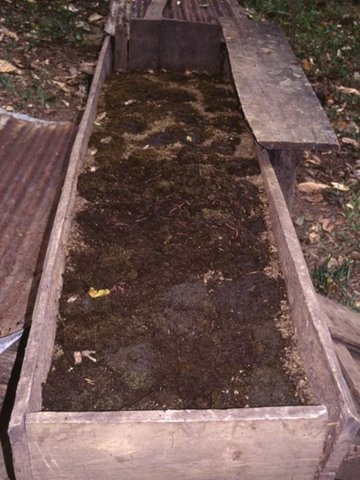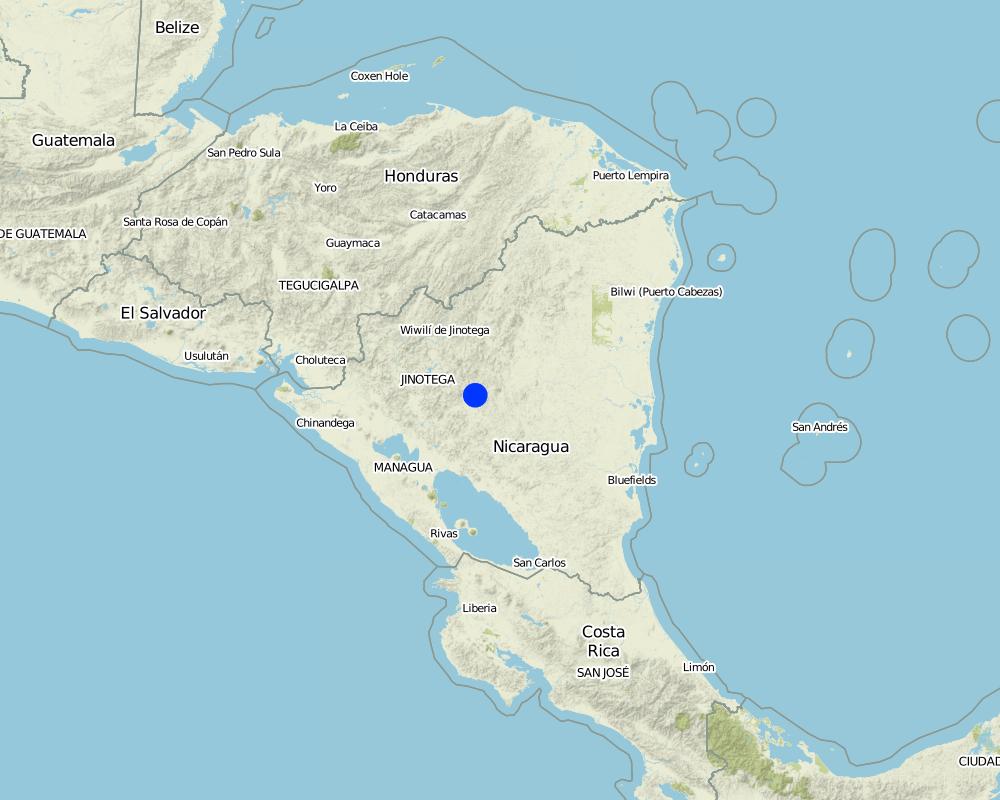Productive development and food security programme [ນິກາຣາກວາ]
- ການສ້າງ:
- ປັບປູງ:
- ຜູ້ສັງລວມຂໍ້ມູນ: Philippe Zahner
- ບັນນາທິການ: –
- ຜູ້ທົບທວນຄືນ: David Streiff, Deborah Niggli
approaches_2349 - ນິກາຣາກວາ
ເບິ່ງພາກສ່ວນ
ຂະຫຍາຍທັງໝົດ ຍຸບທັງໝົດ1. ຂໍ້ມູນທົ່ວໄປ
1.2 ລາຍລະອຽດ ການຕິດຕໍ່ ຂອງບຸກຄົນທີ່ຊັບພະຍາກອນ ແລະ ສະຖາບັນ ການມີສ່ວນຮ່ວມ ໃນການປະເມີນຜົນ ແລະ ເອກະສານ ຂອງວິທີທາງ
ຜູ້ຊ່ຽວຊານ ດ້ານການຄຸ້ມຄອງ ທີ່ດິນແບບຍືນຍົງ:
Gómez Julio
(505) 0772-7108
addacentral@addac.org
ADDAC Managua, Nicaragua
De ENITEL 3c al Norte y 75 varas al Este. Calle Santa Ana, Apartado Postal 161, Matagalpa, Nicaragua
ຊື່ຂອງໂຄງການ ທີ່ອໍານວຍຄວາມສະດວກ ໃນການສ້າງເອກກະສານ ຫຼື ປະເມີນດ້ານແນວທາງ (ຖ້າກ່ຽວຂ້ອງ)
Book project: where the land is greener - Case Studies and Analysis of Soil and Water Conservation Initiatives Worldwide (where the land is greener)ຊື່ຂອງ ສະຖາບັນການຈັດຕັ້ງ ທີ່ອໍານວຍຄວາມສະດວກ ໃນການສ້າງເອກກະສານ ຫຼື ປະເມີນແນວທາງ (ຖ້າກ່ຽວຂ້ອງ)
Asociación para la Diversificación y el Desarrollo Agricultural Comunal (ADDAC) - ນິກາຣາກວາ1.3 ເງື່ອນໄຂ ຂອງການນໍາໃຊ້ເອກກະສານຂໍ້ມູນ ຂອງ WOCAT
ຜູ້ສັງລວມ ແລະ ບັນດາຜູ້ຕອບແບບສອບຖາມ ຍອມຮັບໃນເງື່ອນໄຂ ການນໍາໃຊ້ຂໍ້ມູນເອກະສານ ທີ່ສ້າງຂື້ນ ໂດຍຜ່ານ ອົງການ WOCAT:
ແມ່ນ
1.4 ເອກະສານອ້າງອີງ (ຫຼາຍ) ກັບແບບສອບຖາມ (ຫຼາຍ) ເຕັກໂນໂລຢີ ຂອງດ້ານການຄຸ້ມຄອງ ດິນແບບຍືນຍົງ

Vermiculture [ນິກາຣາກວາ]
Continuous breeding of earthworms in boxes for production of high quality organic compost.
- ຜູ້ສັງລວມຂໍ້ມູນ: Ramén Ernesto Caceres Ordonez
2. ພັນລະນາ ແນວທາງການຄຸ້ມຄອງນໍາໃຊ້ດິນແບບຍືນຍົງ
2.1 ການອະທິບາຍ ໂດຍຫຍໍ້ ຂອງວິທີທາງ
An integrated programme-based approach promoting participatory testing and extension of various SWC technologies, as well as providing institutional support.
2.2 ການອະທິບາຍ ລາຍລະອຽດ ຂອງວິທີທາງ
ການອະທິບາຍ ລາຍລະອຽດ ຂອງວິທີທາງ:
Aims / objectives: The Association for Agricultural Community Development and Diversification (ADDAC) is a non-profit NGO, founded in 1989, whose mission is to improve the living standard of poor rural families engaged in small/medium scale farming in marginal areas to the north of Nicaragua. The main purpose of ADDAC's approach is to develop and strengthen local capacity to analyse problems and find solutions for rural sustainable development. There are five main components: (1) food security and productive development, including technological improvement and diversification within traditional crop cultivation, and extension of alternative agricultural land use practices; (2) support to farmers??? organisations; (3) promotion of gender equality; (4) identification of alternatives in marketing; and (5) provision of an alternative credit system for farming. These fields of activities are based on the principles of organic agriculture and a powerful training process - using the methodology of 'popular education', which involves participatory training and extension activities.
Methods: ADDAC initiates its work in communities through PRA (Participatory Rural Appraisal) - evaluating problems and potential solutions. These serve as a base for the formulation of project proposals which are then submitted to interested financing organisations. Further steps include participatory planning, and later, evaluation, in collaboration with the land users. For execution of activities ADDAC contracts an interdisciplinary crew of specialists, which stays in the area. Twice a year a participatory reunion is organised to evaluate, and accordingly improve, the activities. Key to the approach is the formation of a grassroots organisation in each community to guarantee local management, build up alternative enterprises and promote community development. These organisations consist of representatives of local support groups, and farmers with a leading role in SWC application and extension. The organisations have various functions during the lifetime of a project: they are the counterparts of the extensionists for project execution, and later they ensure sustainability of activities. Farmers' associations are formed to improve storage and marketing of crops. Networks of local promoters exchange experience between communities and consolidate extension of alternative technologies. Demonstration farms serve as a tool for technology extension, innovation and validation.
2.5 ປະເທດ / ເຂດ / ສະຖານທີ່ບ່ອນທີ່ແນວທາງໄດ້ຖືກນໍາໃຊ້
ປະເທດ:
ນິກາຣາກວາ
ພາກພື້ນ / ລັດ / ແຂວງ:
Matagalpa
Map
×2.6 ວັນທີເລີ່ມຕົ້ນ ແລະ ສິ້ນສຸດ ການຈັດຕັ້ງປະຕີບັດ ວິທີທາງ
ສະແດງປີຂອງການເລີ່ມຕົ້ນ:
1989
2.7 ປະເພດຂອງແນວທາງ
- ພາຍໃຕ້ໂຄງການ / ແຜນງານ
2.8 ເປົ້າໝາຍ / ຈຸດປະສົງຫຼັກ ຂອງການຈັດຕັ້ງປະຕິບັດ ວິທີທາງ
Support the economical sustainability and food security of land users in the project area through increased production, diversification, soil conservation and environmental protection. - develop feasible production models, aimed at self-sufficiency and the integration of land users into an alternative internal and external market; build up alternative forms of marketing and credit systems. - community development and capacity building: build-up local farmers' organisation
The SLM Approach addressed the following problems: Lack of organisation and skills to analyse and overcome underlying problems of: - poverty; lack of financial resources for investments (eg in SWC). - insufficient food/poor nutrition. - soil degradation/indiscriminate burning of vegetation. - lack of appropriate technologies. - lack of access to public services and markets
2.9 ເງື່ອນໄຂອໍານວຍ ຫຼື ຂັດຂວາງການປະຕິບັດຂອງເຕັກໂນໂລຢີ / ເຕັກໂນໂລຢີການນໍາໃຊ້ຕາມແນວທາງ
ສັງຄົມ / ວັດທະນະທໍາ / ມາດຕະຖານ ແລະ ຄຸນຄ່າທາງສາສະໜາ
- ເຊື່ອງຊ້ອນ
Resistance to implement SWC technologies by some land users
Treatment through the SLM Approach: Awareness raising, demonstration plots, convince with facts.
ມີຄວາມສາມາດ / ເຂັ້າເຖິງຊັບພະຍາກອນດ້ານການເງິນ ແລະ ການບໍລິການ
- ເຊື່ອງຊ້ອນ
Poverty, lack of resources for investments into SWC.
Treatment through the SLM Approach: Support in the form of credit, basically in kind but also in cash (see credit section).
ການກໍ່ຕັ້ງສະຖາບັນ
- ເຊື່ອງຊ້ອນ
Lack of collaboration between land users.
Treatment through the SLM Approach: Strengthen farmers' organisation.
ກ່ຽວກັບກົດໝາຍ (ສິດນໍາໃຊ້ດິນ, ສິດນໍາໃຊ້ນໍ້າ)
- ອໍານວຍ
Most of the land users have individual properties which facilitates the implementation of the SWC approach activities.
- ເຊື່ອງຊ້ອນ
Lack of land use rights.
Treatment through the SLM Approach: Problem cannot be resolved under the project.
3. ການມີສ່ວນຮ່ວມ ແລະ ບົດບາດຂອງພາກສ່ວນທີ່ກ່ຽວຂ້ອງທີ່ໄດ້ມີສ່ວນຮ່ວມ
3.1 ຜູ້ມີສ່ວນຮ່ວມ ໃນວິທີທາງ ແລະ ພາລະບົດບາດ ຂອງເຂົາເຈົ້າ
- ຜູ້ນໍາໃຊ້ດິນໃນທ້ອງຖິ່ນ / ຊຸມຊົນທ້ອງຖິ່ນ
The integration of women is a key element of the approach. Nevertheless, there are moderate differences due to cultural factors: men are mainly in charge of agricultural activities, whereas women work in the household.
- ຜູ້ຊ່ຽວຊານ ການນຄຸ້ມຄອງ ທີ່ດິນແບບຍືນຍົງ / ທີ່ປຶກສາດ້ານກະສິກໍາ
- ພະນັກງານຂັ້ນສູນກາງ (ຜູ້ວາງແຜນ, ຜູ້ສ້າງນະໂຍບາຍ)
3.2 ການມີສ່ວນຮ່ວມຂອງຜູ້ນໍາໃຊ້ທີ່ດິນໃນທ້ອງຖິ່ນ / ຊຸມຊົນທ້ອງຖິ່ນໃນໄລຍະທີ່ແຕກຕ່າງກັນຂອງແນວທາງ
| ການລວບລວມ ເອົາຜູ້ນໍາໃຊ້ດິນ ໃນທ້ອງຖິ່ນ / ຊຸມຊົນທ້ອງຖິ່ນ | ໃຫ້ລະບຸ ຜູ້ໃດທີ່ມີສ່ວນຮ່ວມ ໃນແຕ່ລະກິດຈະກໍາ? | |
|---|---|---|
| ການເລີ່ມຕົ້ນ / ແຮງຈູງໃຈ | ການຮ່ວມມື | rapid/participatory rural appraisal; participatory planning in public meetings |
| ການວາງແຜນ | ການຮ່ວມມື | public meetings, workshops/seminars; assemblies for municipal planning (elaboration of community action plan) |
| ການປະຕິບັດ | ການຮ່ວມມື | responsibility for major steps; execution of the action plans where each community decides |
| ຕິດຕາມກວດກາ / ການປະເມີນຜົນ | ການຮ່ວມມື | Mainly: public meetings; partly: workshop/seminars, measurements/observations; a specialist is in charge of the continuation of activities and of the planning process with each community; annual assembly of delegates representing all communities assisted by ADDAC |
| Research | ການຮ່ວມມື | on-farm; on-farm experimentation with interested land users: assessment of different technologies (variety tests, evaluation of ecological effects, etc) |
3.4 ການຕັດສິນໃຈກ່ຽວກັບການຄັດເລືອກເຕັກໂນໂລຢີຂອງການຄຸ້ມຄອງທີ່ດິນແບບຍືນຍົງ / ເຕັກໂນໂລຢີ
ລະບຸ ຄົນທີ່ຕັດສິນໃຈ ກ່ຽວກັບການຄັດເລືອກຂອງ ເຕັກໂນໂລຢີ / ເຕັກໂນໂລຢີ ຈະໄດ້ຮັບການປະຕິບັດ:
- ຜູ້ນໍາໃຊ້ທີ່ດິນຫຼັກ, ການສະໜັບສະໜູນ ໂດຍຜູ້ຊ່ຽວຊານ ການນໍາໃຊ້ທີ່ດິນແບບຍືນຍົງ
ອະທິບາຍ:
Decisions on the method of implementing the SLM Technology were made by mainly by land users supported by SLM specialists
4. ການສະໜັບສະໜູນທາງດ້ານວິຊາການ, ການສ້າງຄວາມສາມາດ, ແລະ ການຈັດການຄວາມຮູ້.
4.1 ການສ້າງຄວາມສາມາດ / ການຝຶກອົບຮົມ
ຜູ້ນໍາໃຊ້ທີ່ດິນ ຫຼື ພາກສ່ວນກ່ຽວຂ້ອງອື່ນໆ ໄດ້ຮັບການຝຶກອົບຮົມບໍ່?
ແມ່ນ
ຮູບແບບຂອງການຝຶກອົບຮົມ:
- ຕົວຕໍ່ຕົວ
- ເນື້ອທີ່ສວນທົດລອງ
- ກອງປະຊຸມ
ໃນຫົວຂໍ້:
The form of training promoted by ADDAC is called 'popular education'. It is a continuous and participatory process of mutual learning between farmers and technicians, based on a course of 'action - reassessment - action', with the aim of re-establishing indigenous knowledge, improving local self-esteem and the ability to analyse innovations, and, in the long term, to build up the capacity withi
4.2 ການບໍລິການໃຫ້ຄໍາປຶກສາ
ເຮັດຜູ້ໃຊ້ທີ່ດິນມີການເຂົ້າເຖິງການບໍລິການໃຫ້ຄໍາປຶກສາ?
ແມ່ນ
ລະບຸວ່າການສະໜອງ ການບໍລິການ ໃຫ້ຄໍາປຶກສາ:
- ໃນພື້ນທີ່ຂອງຜູ້ນໍາໃຊ້ດິນ
ອະທິບາຍ / ຄວາມຄິດເຫັນ:
Key elements: demonstration areas, technical assistance through farm visits, farmer-to-farmer extension, local promoters organised into 'Local Support Groups', associated network.
4.3 ສະຖາບັນການສ້າງຄວາມເຂັ້ມແຂງ (ການພັດທະນາອົງການຈັດຕັ້ງ)
ສະຖາບັນ ໄດ້ຮັບການສ້າງຕັ້ງຂື້ນ ຫຼື ໄດ້ຮັບການສ້າງຄວາມເຂັ້ມແຂງ ໂດຍການຈັດຕັ້ງປະຕິບັດ ວິທີທາງບໍ່?
- ມີ, ໜ້ອຍໜຶ່ງ
ລະບຸ ທາງສະຖາບັນ ໄດ້ສ້າງຄວາມເຂັ້ມແຂງ ໃນລະດັບໃດ (ຫຼາຍ):
- ທ້ອງຖິ່ນ
- building up groups (see Annexe 3)
4.4 ຕິດຕາມກວດກາ ແລະ ປະເມີນຜົນ
ການຈັດຕັ້ງປະຕິບັດ ວິທີທາງ ໄດ້ມີການປະເມີນຜົນ ແລະ ຕິດຕາມບໍ?
ແມ່ນ
ຄວາມຄິດເຫັນ:
Socio-cultural aspects were ad hoc monitored by 0 through observations; indicators: land users needs
Economic / production aspects were ad hoc monitored by 0 through observations; indicators: nutritional security, cost-benefit-ratio, deversification, organic products, certified production, production for markets
No. of land users involved aspects were regular monitored by 0 through measurements; indicators: strategic plan, progress of project
Management of Approach aspects were regular monitored by None through measurements; indicators: None
Training aspects were regular monitored by None through observations; indicators: land users trained as local promoters
There were several changes in the Approach as a result of monitoring and evaluation: at the beginning the approach consisted only of two components: training and research. Then it was broadened to involve extension of SWC technologies and promotion of crop diversification. Later the credit programme and the organisational component became part of the approach. The approach activities are supposed to be a continuously expanded based on the needs of the land users.
4.5 ການຄົ້ນຄວ້າ
ນີ້້ແມ່ນສ່ວນໜຶ່ງ ການຄົ້ນຄວ້າ ຂອງວິທີທາງບໍ່?
ແມ່ນ
ລະບຸ ຫົວຂໍ້:
- ເຕັກໂນໂລຢີ
ໃຫ້ຂໍ້ມູນ ເພີ່ມເຕີມ ແລະ ກໍານົດ ຜູ້ໃດເຮັດການຄົ້ນຄວ້າ:
Research is carried out on demonstration farms through local promoters. Topics include on-farm testing of technologies, and adaptive trials with maize and pea varieties.
5. ການສະໜັບສະໜູນທາງດ້ານການເງິນ ແລະ ອຸປະກອນຈາກພາຍນອກ
5.1 ງົບປະມານປະຈໍາປີ ສໍາລັບວິທີທາງ ຂອງການຄຸ້ມຄອງ ທີ່ດິນແບບຍືນຍົງ
ຄໍາເຫັນ (ຕົວຢ່າງ: ແຫຼ່ງຂໍ້ມູນຫຼັກ ຂອງການສະໜອງທຶນ / ຜູ້ໃຫ້ທຶນທີ່ສໍາຄັນ):
Approach costs were met by the following donors: international non-government (-): 90.0%; national non-government (-): 10.0%
5.2 ການສະໜັບສະໜູນ ທາງດ້ານການເງິນ / ອຸປະກອນ ສະໜອງໃຫ້ແກ່ຜູ້ນໍາທີ່ດິນ
ຜູ້ນໍາໃຊ້ດິນ ໄດ້ຮັບການສະໜັບສະໜູນ ທາງດ້ານ ການເງິນ / ອຸປະກອນ ໃນການຈັດຕັ້ງປະຕິບັດ ເຕັກໂນໂລຢີບໍ?
ບໍ່ແມ່ນ
5.3 ເງິນສົມທົບສໍາລັບການນໍາໃຊ້ສະເພາະປັດໃຈຂາເຂົ້າໃນການຜະລີດກະສິກໍາ (ລວມທັງແຮງງານ)
- ອຸປະກອນ
| ໃຫ້ລະບຸໄດ້ຮັບການສະໜັບສະໜູນປັດໃຈຂາເຂົ້າຫຍັງແດ່ | ທີ່ຂອບເຂດ | ລະບຸ ການອຸດໜູນ |
|---|---|---|
| ເຄື່ອງມື | ງົບປະມານບາງສ່ວນ | |
- ກະສິກໍາ
| ໃຫ້ລະບຸໄດ້ຮັບການສະໜັບສະໜູນປັດໃຈຂາເຂົ້າຫຍັງແດ່ | ທີ່ຂອບເຂດ | ລະບຸ ການອຸດໜູນ |
|---|---|---|
| fresh cattle manure | Gift from neigbours to farmers who don't have cattle | |
- ພື້ນຖານໂຄງລ່າງ
| ໃຫ້ລະບຸໄດ້ຮັບການສະໜັບສະໜູນປັດໃຈຂາເຂົ້າຫຍັງແດ່ | ທີ່ຂອບເຂດ | ລະບຸ ການອຸດໜູນ |
|---|---|---|
| community infrastructure | ງົບປະມານເຕັມສ່ວນ | |
ຖ້າແຮງງານ ຂອງຜູ້ນໍາໃຊ້ດິນ ໄດ້ຮັບການສະໜັບສະໜູນ ປັດໃຈຂາເຂົ້າ, ແມ່ນບໍ່:
- ການອາສາ
ຄວາມຄິດເຫັນ:
land users works on their own farms at their own cost.
5.4 ສິນເຊື່ອ
ໄດ້ປ່ອຍສິນເຊື່ອ ສະໜອງໃຫ້ພາຍໃຕ້ ວິທີການສໍາລັບກິດຈະກໍາ ການຄຸ້ມຄອງ ທີ່ດິນແບບຍືນນຍົງບໍ່?
ແມ່ນ
ເງື່ອນໄຂກໍານົດ (ອັດຕາດອກເບ້ຍ, ຈ່າຍຄືນ, ແລະ ອື່ນໆ) :
Interest rate charged: 1.5%; repayment conditions: Credit was provided through the programme of alternative financing by ADDAC. The 1.5% interest rate (lower than the market rate) is accessible to individuals and organised groups..
Interest was lower than market rate.
6. ວິເຄາະຜົນກະທົບ ແລະ ສັງລວມບັນຫາ
6.1 ຜົນກະທົບຂອງແນວທາງ
ການຈັດຕັ້ງປະຕິບັດ ວິທີທາງ ສາມາດຊ່ວຍຜູ້ນໍາໃຊ້ທີ່ດິນ ໃນການຈັດຕັ້ງປະຕິບັດ ແລະ ບໍາລຸງຮັກສາ ເຕັກໂນໂລຢີ ການຄຸ້ມຄອງ ທີ່ດິນແບບຍືນຍົງໄດ້ບໍ?
- ບໍ່
- ມີ, ໜ້ອຍໜຶ່ງ
- ມີ, ພໍສົມຄວນ
- ມີ, ຫຼາຍ
Did other land users / projects adopt the Approach?
- ບໍ່
- ມີ, ໜ້ອຍໜຶ່ງ
- ມີ, ພໍສົມຄວນ
- ມີ, ຫຼາຍ
There are 6 more projects assisted by ADDAC, which use the same approach in the north of Nicaragua.
6.3 ຄວາມຍືນຍົງຂອງກິດຈະກໍາວິທີທາງ
ຜູ້ນໍາໃຊ້ ທີ່ດິນ ສາມາດສືບຕໍ່ ການຈັດຕັ້ງປະຕິບັດ ຜ່ານວິທີທາງໄດ້ບໍ່ (ໂດຍປາດສະຈາກ ການຊ່ວຍເຫຼືອ ຈາກພາກສ່ວນພາຍນອກ)?
- ແມ່ນ
6.4 ຈຸດແຂງ / ຂໍ້ດີ ຂອງວິທີທາງ
| ຈຸດແຂງ / ຈຸດດີ / ໂອກາດ ຈາກທັດສະນະຂອງຜູ້ປ້ອນຂໍ້ມູນ ຫຼື ບຸກຄົນສຳຄັນ |
|---|
| Growing active integration of women (25% more contribution to farm income and >25% more participation in decision making in comparison with non-participants) (How to sustain/ enhance this strength: Keep the gender programme as a component of the approach.) |
| Farmers' organisations: build up capacity for autonomous management of alternative development activities (How to sustain/ enhance this strength: Integrate more farmers in the baseline organisations.) |
| Efficient extension method: 86% of involved land users apply more than 3 different SWC technologies promoted by the approach which contributes to sustainable development of the region (How to sustain/ enhance this strength: Maintain and extend present farmer-to-farmer extension system: continue training of local promoters, network of promoters, local support group.) |
| Evaluation of land users' needs and involvement of new approach components according to their needs; continuous mutual learning process between land users and between land users and extensionists/specialists (How to sustain/ enhance this strength: Continue the present 6-monthly evaluation procedures; implement a system of information, communication, evaluation and monitoring to analyse the impact of the approach activities.) |
| Increasing self-esteem of the people. |
6.5 ຈຸດອ່ອນ / ຂໍ້ເສຍຂອງແນວທາງ ແລະ ວິທີການແກ້ໄຂໃຫ້ເຂົາເຈົ້າ
| ຈຸດອ່ອນ ຫຼື ຂໍ້ເສຍ ຫຼື ຄວາມສ່ຽງ ໃນມຸມມອງຂອງ ຜູ້ສັງລວມຂໍ້ມູນ ຫຼື ບັນດາຜູ້ຕອບແບບສອບຖາມ | ມີວິທີການແກ້ໄຂຄືແນວໃດ? |
|---|---|
| Process takes long and requires high inputs of human resources and materials | In an integrated approach with strong participation of land users this problem is unavoidable; formulation of good project proposals help in finding donors to finance long-term programmes. |
7. ເອກກະສານອ້າງອີງ ແລະ ຂໍ້ມູນການເຊື່ອມໂຍງ
7.1 ວິທີການ / ແຫຼ່ງຂໍ້ມູນ
- ການໄປຢ້ຽມຢາມພາກສະໜາມ, ການສໍາຫຼວດພາກສະໜາມ
- ການສໍາພາດ ຜູ້ນໍາໃຊ້ທີ່ດິນ
7.2 ເອກະສານທົ່ວໄປທີ່ສາມາດໃຊ້ໄດ້
ຫົວຂໍ້, ຜູ້ຂຽນ, ປີ, ISBN:
Rolando Bunch (1990) Dos Mazorcas de Ma??z Anon (1990) El peque?? agricultor en Honduras ADDAC (2002) Plan
ຂໍ້ມູນການເຊື່ອມຕໍ່ ແລະ ເນື້ອໃນ
ຂະຫຍາຍທັງໝົດ ຍຸບທັງໝົດການເຊື່ອມຕໍ່

Vermiculture [ນິກາຣາກວາ]
Continuous breeding of earthworms in boxes for production of high quality organic compost.
- ຜູ້ສັງລວມຂໍ້ມູນ: Ramén Ernesto Caceres Ordonez
ເນື້ອໃນ
ບໍ່ມີເນື້ອໃນ


